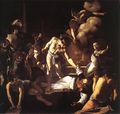Difference between revisions of "Stories from the Life of St. Matthew (1600-1602 Caravaggio), art"
| Line 1: | Line 1: | ||
'''Stories from the Life of St. Matthew ''' (1600-1602) is a cycle of paintings by [[Caravaggio]]. | '''Stories from the Life of St. Matthew ''' (1600-1602) is a cycle of paintings by [[Caravaggio]]. | ||
== | ==Overview== | ||
Caravaggio was the first artist to give the character of Matthew a life of his own. His work was celebrated, admired and widely imitated for centuries. | Caravaggio was the first artist to give the character of Matthew a life of his own. His work was celebrated, admired and widely imitated for centuries. | ||
The ''Life of St. Matthew'' is illustrated in three episodes: | The ''Life of St. Matthew'' is illustrated in three episodes: | ||
<gallery> | |||
File:Calling Matthew Caravaggio.jpg|1. [[Calling of St. Matthew (1600 Caravaggio), art]] | |||
File:Matthew Caravaggio.jpg|2. [[Inspiration of St. Matthew (1602 Caravaggio), art]] | |||
File:Angel Matthew Caravaggio.jpg|(2a. [[St. Matthew and the Angel (1602 Caravaggio), art]]) [lost in 1945] | |||
File:Martyrdom Matthew Caravaggio.jpg|3. [[Martyrdom of St. Matthew (1600 Caravaggio), art]] | |||
</gallery> | |||
Caravaggio painted the three stories from the life of Matthew to decorate the Contarelli Chapel in the church of San Luigi dei Francesi in Rome [Italy], where they are still located. The original version of the ''Inspiration of St. Matthew'' (known as [[St. Matthew and the Angel (1602 Caravaggio), art]]) was rejected and the Author had to replace it with the current painting. The rejected painting was purchased by Vincenzo Giustiniani for his private collection and eventually ended in Berlin [Germany] at the Kaiser Friedrich Museum, where it was destroyed in 1945 in the last days of World War II. | |||
Caravaggio painted the three stories from the life of Matthew to decorate the Contarelli Chapel in the church of San Luigi dei Francesi in Rome [Italy], where they are still located. The original version of the ''Inspiration of St. Matthew'' was purchased by Vincenzo Giustiniani for his private collection and eventually ended in Berlin [Germany] at the Kaiser Friedrich Museum, where it was destroyed in 1945 in the last days of World War II. | |||
==External links== | ==External links== | ||
| Line 21: | Line 23: | ||
[[Category:1600| Caravaggio]] | [[Category:1600|*Caravaggio]] | ||
[[Category:Fiction|1600 Caravaggio]] | [[Category:Fiction|1600 Caravaggio]] | ||
[[Category:Art|1600 Caravaggio]] | [[Category:Art|1600 Caravaggio]] | ||
| Line 30: | Line 32: | ||
[[Category:Made in the 1600s|*1600 Caravaggio]] | [[Category:Made in the 1600s|*1600 Caravaggio]] | ||
[[Category:Matthew (subject)|1600 Caravaggio]] | [[Category:Matthew (subject)|1600 Caravaggio]] | ||
[[Category:Matthew--fiction (subject)|1600 Caravaggio]] | [[Category:Matthew--fiction (subject)|1600 Caravaggio]] | ||
[[Category:Matthew--art (subject)|1600 Caravaggio]] | [[Category:Matthew--art (subject)|1600 Caravaggio]] | ||
Revision as of 01:58, 6 August 2014
Stories from the Life of St. Matthew (1600-1602) is a cycle of paintings by Caravaggio.
Overview
Caravaggio was the first artist to give the character of Matthew a life of his own. His work was celebrated, admired and widely imitated for centuries.
The Life of St. Matthew is illustrated in three episodes:
(2a. St. Matthew and the Angel (1602 Caravaggio), art) [lost in 1945]
Caravaggio painted the three stories from the life of Matthew to decorate the Contarelli Chapel in the church of San Luigi dei Francesi in Rome [Italy], where they are still located. The original version of the Inspiration of St. Matthew (known as St. Matthew and the Angel (1602 Caravaggio), art) was rejected and the Author had to replace it with the current painting. The rejected painting was purchased by Vincenzo Giustiniani for his private collection and eventually ended in Berlin [Germany] at the Kaiser Friedrich Museum, where it was destroyed in 1945 in the last days of World War II.



